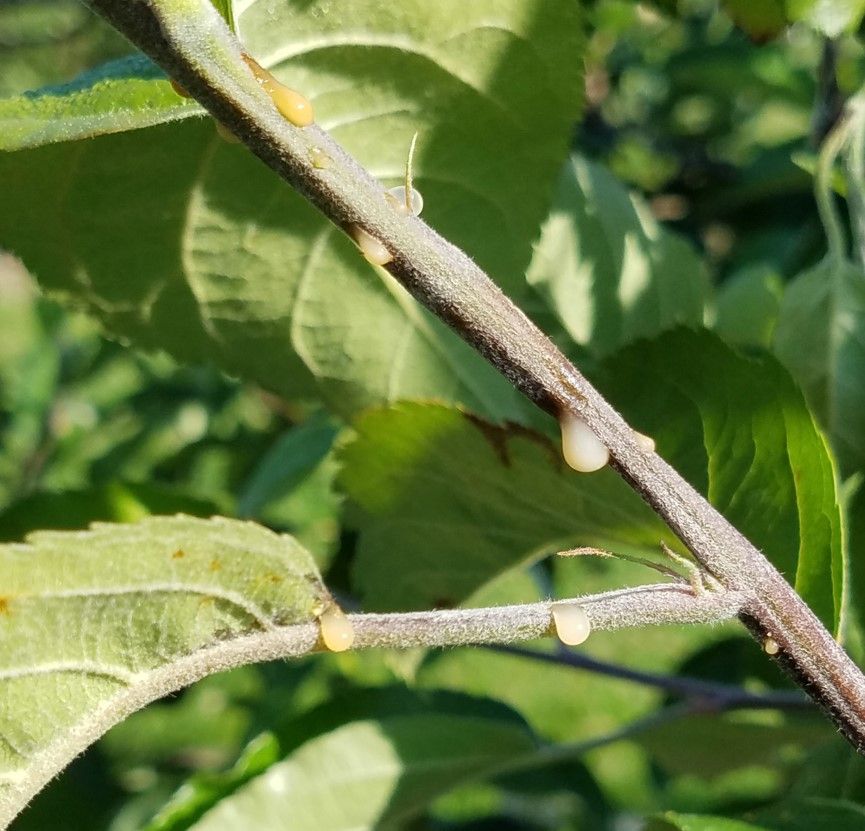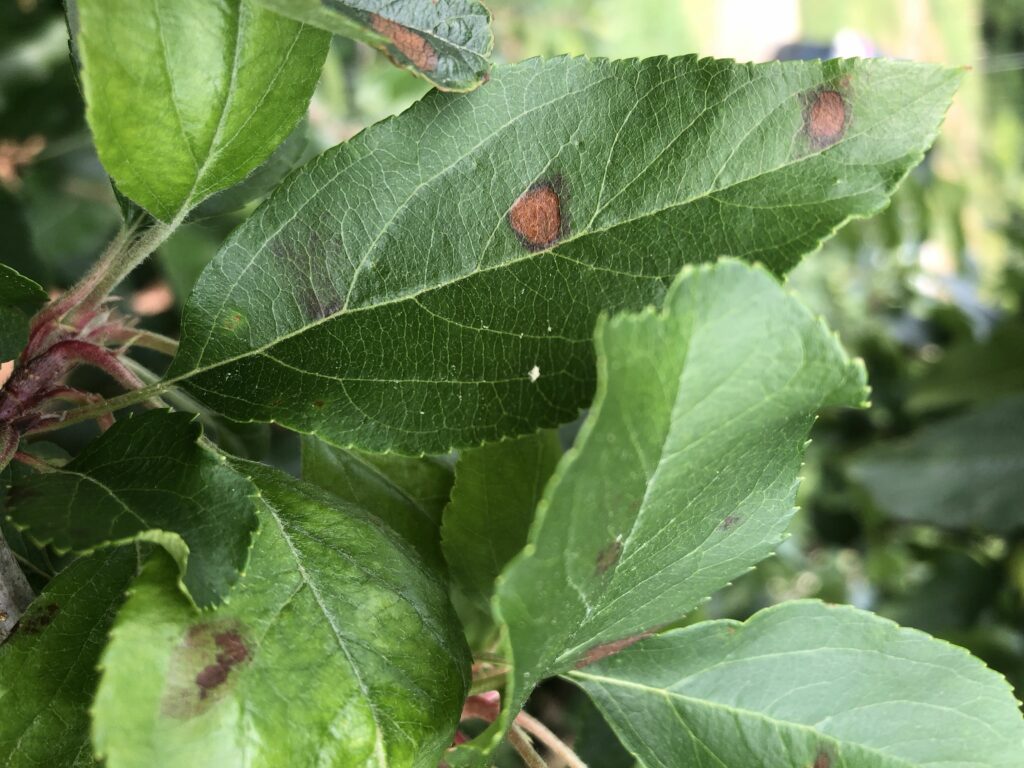Apple Disease Update: Week of May 10, 2021
go.ncsu.edu/readext?796279
en Español / em Português
El inglés es el idioma de control de esta página. En la medida en que haya algún conflicto entre la traducción al inglés y la traducción, el inglés prevalece.
Al hacer clic en el enlace de traducción se activa un servicio de traducción gratuito para convertir la página al español. Al igual que con cualquier traducción por Internet, la conversión no es sensible al contexto y puede que no traduzca el texto en su significado original. NC State Extension no garantiza la exactitud del texto traducido. Por favor, tenga en cuenta que algunas aplicaciones y/o servicios pueden no funcionar como se espera cuando se traducen.
Português
Inglês é o idioma de controle desta página. Na medida que haja algum conflito entre o texto original em Inglês e a tradução, o Inglês prevalece.
Ao clicar no link de tradução, um serviço gratuito de tradução será ativado para converter a página para o Português. Como em qualquer tradução pela internet, a conversão não é sensivel ao contexto e pode não ocorrer a tradução para o significado orginal. O serviço de Extensão da Carolina do Norte (NC State Extension) não garante a exatidão do texto traduzido. Por favor, observe que algumas funções ou serviços podem não funcionar como esperado após a tradução.
English
English is the controlling language of this page. To the extent there is any conflict between the English text and the translation, English controls.
Clicking on the translation link activates a free translation service to convert the page to Spanish. As with any Internet translation, the conversion is not context-sensitive and may not translate the text to its original meaning. NC State Extension does not guarantee the accuracy of the translated text. Please note that some applications and/or services may not function as expected when translated.
Collapse ▲ The destruction of the two cold snaps on fruit production and quality is beginning to come to light for many apple growers throughout the region. For the remainder of this year my plan is to send out weekly updates/management options for different production scenarios based on cultivar susceptibility to disease, % of crop remaining, and targeted markets for remaining apples. I will also include my usual “diseases to watch out for this week” segments. Unfortunately, I will likely be unable to account for all financial considerations or production questions in these short posts so please feel free to email me (sara_villani@ncsu.edu) for any follow-up questions/concerns!
The destruction of the two cold snaps on fruit production and quality is beginning to come to light for many apple growers throughout the region. For the remainder of this year my plan is to send out weekly updates/management options for different production scenarios based on cultivar susceptibility to disease, % of crop remaining, and targeted markets for remaining apples. I will also include my usual “diseases to watch out for this week” segments. Unfortunately, I will likely be unable to account for all financial considerations or production questions in these short posts so please feel free to email me (sara_villani@ncsu.edu) for any follow-up questions/concerns!
Diseases to Be on the Lookout For…
Disease Concern 1: Shoot Blight
Regardless if you have an apple crop this year, I’ll put money on it that your trees still have leaves and shoots remaining. This young, succulent tissue is prime location for infection by the fire blight pathogen, Erwinia amylovora. Injury to this susceptible leaf tissue provides the means for bacteria to invade and progress down young shoots. Insects with sucking or piercing mouth parts, or other types of wounds created from environmental conditions (e.g. hail, wind, soil abrasion, etc). Application of a plant growth regulator, prohexadione calcium (marketed as Apogee or Kudos) has demonstrated the greatest efficacy against shoot blight in commercial plantings and in research trials. The chemical retards shoot growth, thereby reducing the amount of susceptible tissue available, and also thickens xylem cell walls acting as a barrier to the bacterium. At least two applications of prohexadione calcium should be applied during the season for shoot blight management. For mature trees a 6-12 oz/100 gal rate is recommended at 1-3″ of shoot growth and then 14-21 days later (considering the late season vigor in NC, I’d lean towards the 12 oz/100 gal rate). For trees less than 5 years old in which you are trying to fill the canopy, make applications at the same timings but at a reduced rate of 3-6 oz/100 gallons (again, I’d lean towards the higher rate, especially in trees 3rd leaf or older). Even if you have not yet made an application, I would still encourage starting now. Make sure to follow label guidelines on the addition of water softeners and penetrating adjuvant when making an application. Also, do not apply calcium in tank mixture with ProCa. Again, all trees regardless if there is a crop or not should be protected against shoot blight.
Disease Concern 2: Powdery Mildew
I am beginning to see signs and symptoms of powdery mildew popping up in my ‘Rome Beauty’ block. Often when I visit apple growers, ‘Jonagold’ is also one of the common cultivars in which I notice mildew symptoms. The powdery mildew pathogen overwinters in dormant buds that were infected during the previous growing season. Infected shoots with primary mildew (shoots in which dormant bud was infected) will be stunted, malformed, and have a white/silver color (see above). Secondary powdery mildew infections on foliage will appear as white, fuzzy tufts on either side of the leaf. Older lesions look burnt out and can take on a red/purple color. Leaves with severe infection curl inward. As leaves age they become increasingly resistant to infection.
To date, my level of concern about spraying fungicides specifically for Glomerella leaf spot and bitter rot has been fairly low. HOWEVER, this week will remain cool, and temperatures not likely to exceed 59 deg. F during wetting events (rain or dew). However, in warmer regions of the state, rain should be able to dislodge any mature spores that may be overwintering on leaf debris on the ground.
If this is your situation, from a disease management standpoint my suggestion would be to continue with a normal disease management program as you would in during any standard growing season. I realize that financially, if this a reduced crop, then perhaps including some of the more expensive chemicals such as Merivon or Inspire Super may not be feasible. You will likely able to get by with a protectant fungicide program of captan + mancozeb (stay within seasonal limits and PHI) on a seven to ten-day interval. Consider incorporating a DMI fungicide (Procure or Rally) or sulfur to help with mildew control over the next few weeks. Also, consider adding Topsin or a generic thiophanate methyl fungicide for flyspeck and sooty blotch management (every other spray).



